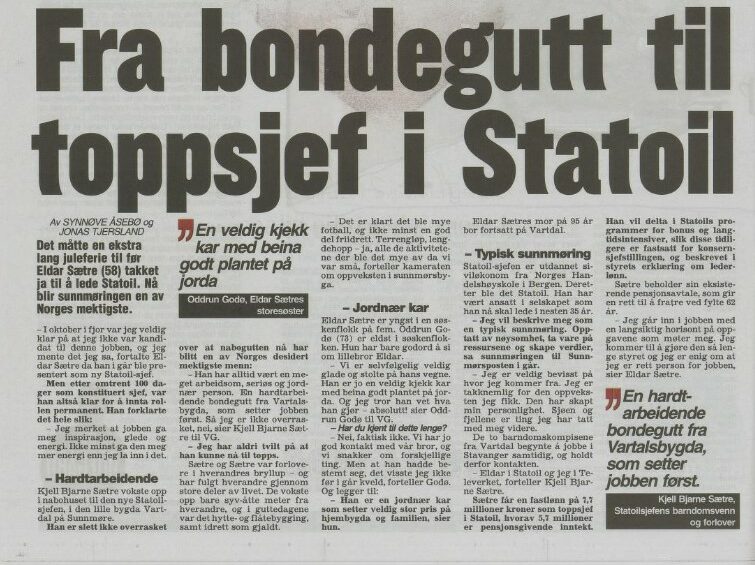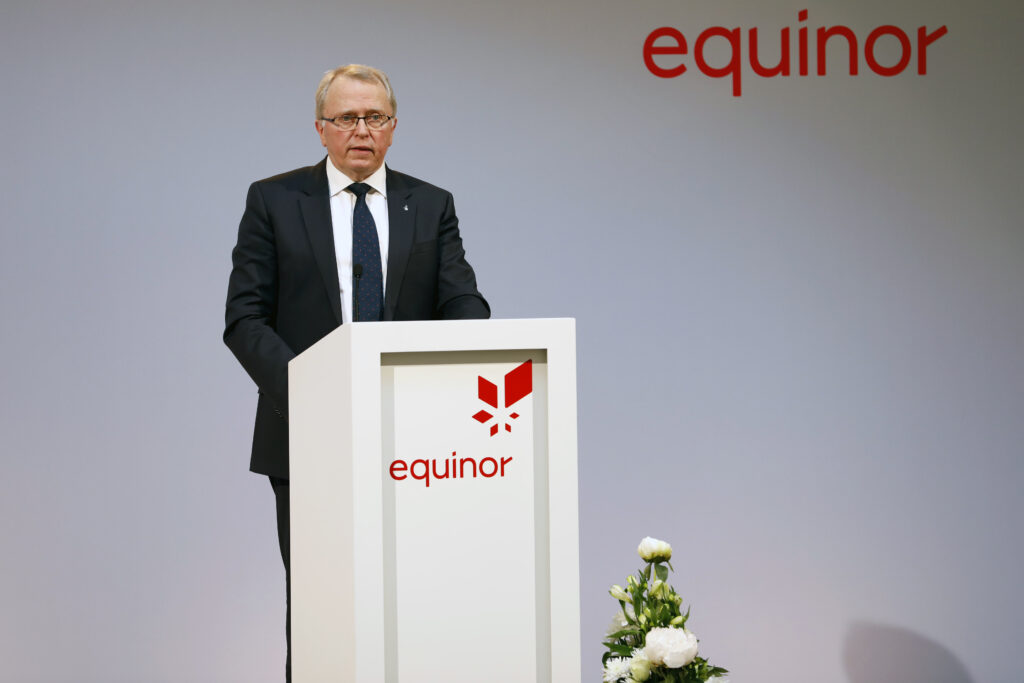Eldar Sætre – continuity in the company

Sætre has always been there – or almost, at least. The promising young economist joined Statoil in 1980 and stayed for the rest of his career. This continuity distinguishes him from the company’s earlier CEOs. In common with them, however, he has a degree in business economics from the Norwegian School of Economics.
He rose through the ranks during the 1980s and 1990s, including as a finance manager at various levels,[REMOVE]Fotnote: Annual report, 2004, Statoil: 58. (References to annual reports in this text refer to the Norwegian edition of the reports.) and played a key role in the run-up to partial privatisation in 2001. Ahead of the public listing, for example, he worked on presenting Statoil to potential investors – a new exercise for a company which had previously been wholly state-owned.[REMOVE]Fotnote: Lerøen, Bjørn Vidar, 2002. Drops of black gold. Statoil 1972-2002. Statoil: 106-108.
Joining top management
When Olav Fjell resigned as CEO in September 2003, Sætre joined the corporate executive committee (CEC) for the first time as acting chief financial officer (CFO) after Inge K. Hansen became acting CEO. When Helge Lund was finally able to take office as the permanent CEO in August 2004, Sætre was confirmed as CFO.
He remained in that post for a further six years, exercising substantial influence over Lund’s growth perspectives and the adoption of more dynamic management for the company’s finances.[REMOVE]Fotnote:Boon, Marten, 2022, En nasjonal kjempe. Statoil og Equinor etter 2001. Universitetsforlaget: 123-128.
One way to expand was merging with other companies. The prime candidate for a possible amalgamation was Norsk Hydro’s oil and energy division. Together with Lund and Hydro CEO Eivind Reiten, Sætre and John O. Ottestad, his opposite number at the other Norwegian company, played key roles in laying the basis for a merger.[REMOVE]Fotnote: Ibid: 202.
In December 2010, Sætre became executive vice president for marketing, processing and renewable energy.
Top post
Seldom was the Norwegian saying that “the old ones wear best” more appropriate to Statoil’s history than in the autumn and winter of 2014 and early 2015. Lund resigned in mid-October, and Sætre was appointed acting CEO. However, he claimed to be too old at 58 to take it on permanently.[REMOVE]Fotnote:Skarsaune, Erlend, ”Den sparsommelige vikaren”, Stavanger Aftenblad, 27 November 2014: 30-32.

Nevertheless, it was announced in February 2015 that Sætre had been given the job.[REMOVE]Fotnote: Eldar Sætre new president and CEO of Statoil. (Statoil press release 4 February 2015.) https://www.equinor.com/no/news/archive/2015/02/04/04FebEldarSaetreCEO.html, accessed 4 January 2022. The circumstances were unusual – he was the first CEO recruited from the company’s own ranks. He also succeeded the first CEO who had not been driven out by cost overruns or a corruption case.
Sætre took over in very different times to those which had largely prevailed during Lund’s 10 years in charge. Falling oil prices called for a reduced emphasis on the production growth which had been in forefront over the previous 10-11 years.
Greater attention was eventually paid to selling out of land-based projects in order to concentrate on offshore ventures. Abroad, particular emphasis was given to activities off Brazil.[REMOVE]Fotnote:Boon, Marten, op.cit. 312-319. The big picture was that the strategy for inorganic growth – through the acquisition of other companies, for example – was downscaled under Sætre.
He retained much of the existing management structure, even though some changes were made and certain new people came in. One of the most important alterations was that Anders Opedal, who succeeded Sætre as CEO in 2020, was brought into the CEC as chief operating officer (COO). This newly established function was to be responsible for enhancing efficiency in the company.[REMOVE]Fotnote: Ibid: 305.
Renewable commitment
A separate business area for new energy solutions was established in 2015.[REMOVE]Fotnote: Annual report, 2015, Statoil: 3. (References to annual reports in this text refer to the Norwegian edition of the reports.) Elevating this business to CEC level gave an important signal of an increased commitment.
The climate issue and Statoil was not a new topic. Historian Ada Nissen, for example, has studied interactions on this subject between the Norwegian government and the company in 1990-2005.[REMOVE]Fotnote: Nissen, Ada Elisabeth, 2021, “A greener shade of black? Statoil, the Norwegian government and climate change, 1990-2005”. Scandinavian Journal of History, 46 (3): 408-429. ISSN 0346-8755. doi: 10.1080/03468755.2021.187675.
Around the time Sætre became CEO, the challenges posed for the oil companies – including Statoil – by the green shift increased markedly. Important elements here include the substantial fall in oil prices and the increased pressure to change gear over the energy transition in the wake of the 2015 Paris agreement.
It was clear to Sætre that the company had to take explicit action in these circumstances through an increased commitment to such areas as wind power and carbon capture and storage (CCS).
Moreover, the company’s name should reflect the fundamental changes which had occurred since its creation. First, it had been partially privatised. Second, it wanted to communicate a broader energy consciousness. Another goal was to signal its Norwegian roots. The name chosen was Equinor.

Continuity and change
Some commentators could undoubtedly interpret Sætre as a strategist operating in a framework of continuity. But the question is how the latter concept relates to others – such as change.
In certain circumstances, change can be interpreted as promoting continuity. It could be argued, for example, that partial privatisation was necessary to preserve a viable company for the future. The same can be said about the merger with Hydro. From such a perspective, continuity and change can be seen to go hand-in-hand.
So is there a need, at a time when energy structures are steadily broadening, for a changed view of what can be considered continuity in companies with a long history in the petroleum age?
Partial privatisation, mergers and internationalisation are examples of far-reaching changes which occurred within the framework of Statoil’s identity as a petroleum company.
The climate issue, and the company’s response to it through a commitment to renewable energy, precisely challenges that identity. Showing a willingness and ability to take even more fundamental steps than before is probably more critical than ever.
Given that context, it is probably too early for a final assessment of the long-term consequences of Sætre’s actions as CEO at the interface between continuity and change.
arrow_backSeismic surveying in South AfricaIn the driving seat for subsea compressionarrow_forward